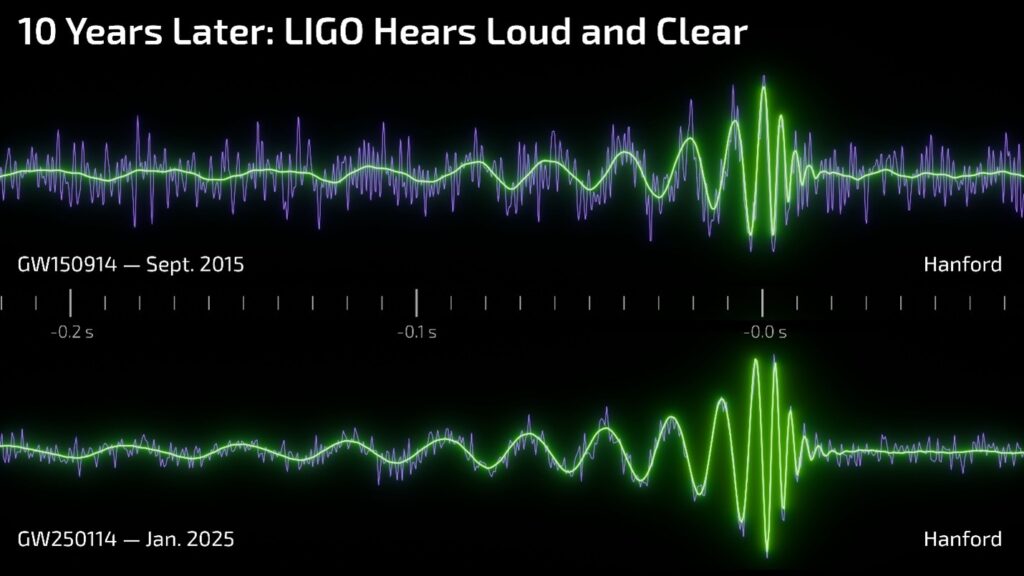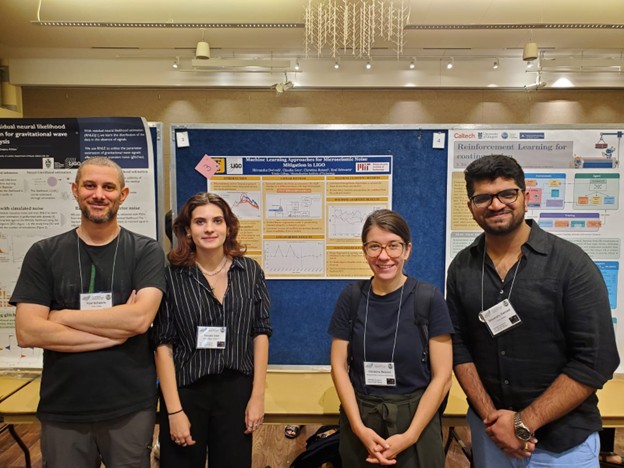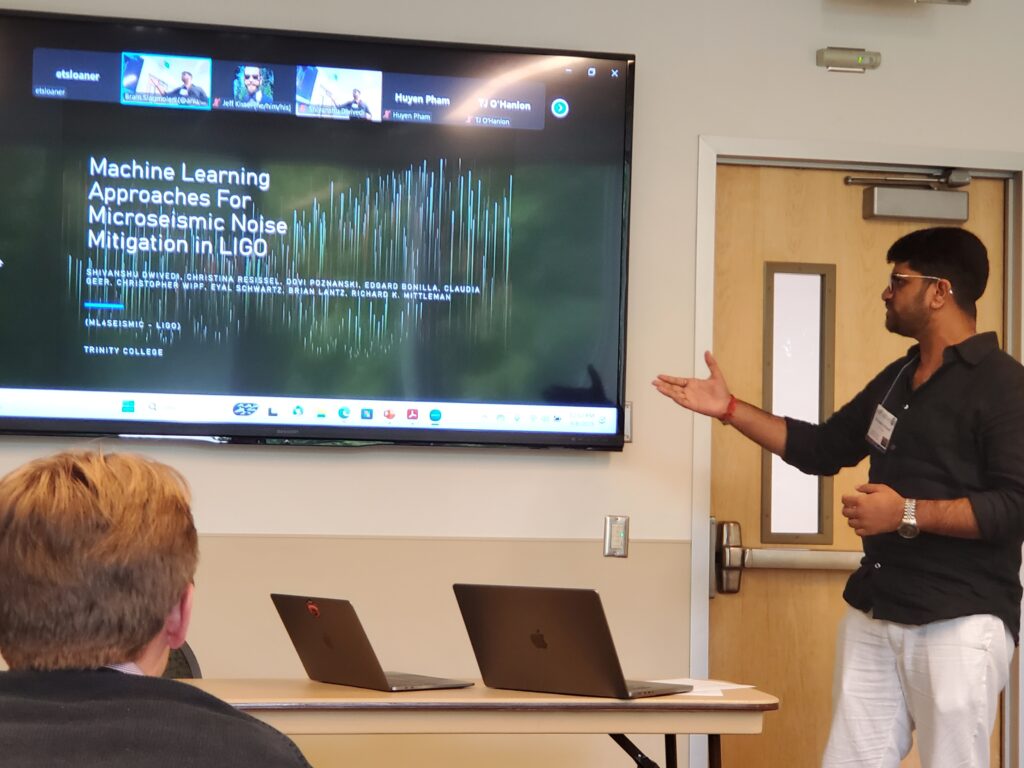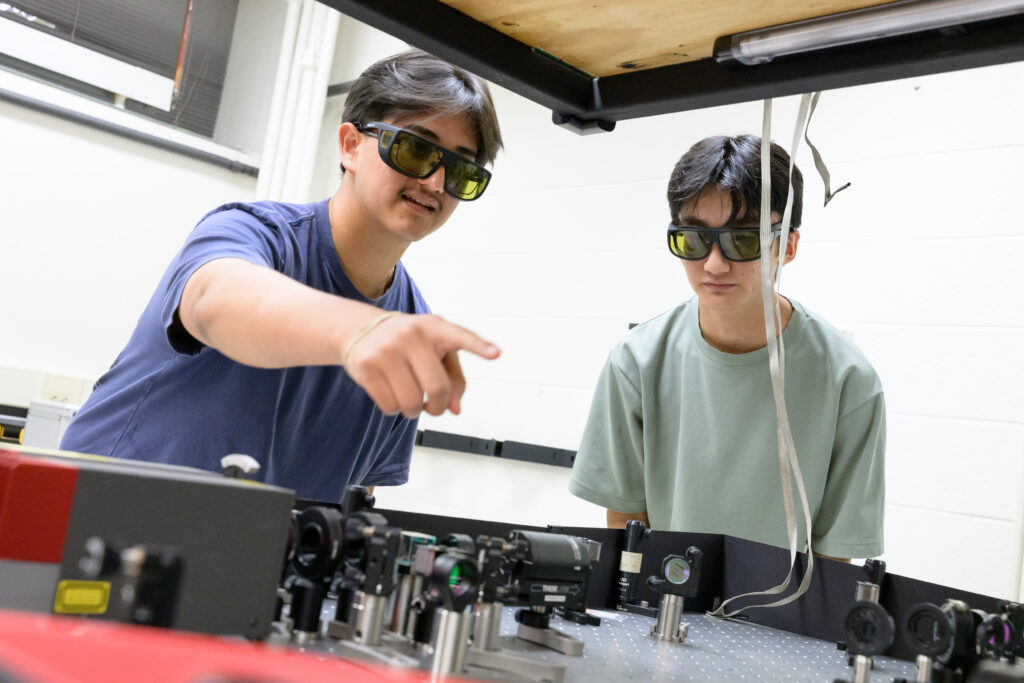Faculty and student researchers at Trinity College played a role in a groundbreaking discovery announced recently by the Laser Interferometer Gravitational-Wave Observatory (LIGO) worldwide scientific collaboration.

On January 14, 2025, scientists observed the clearest gravitational-wave signal ever recorded—a black hole merger known as GW250114. LIGO said that the event confirmed, with unprecedented precision, one of Stephen Hawking’s most important predictions: that the total surface area of black holes cannot decrease when they merge.
Trinity joined the LIGO Scientific Collaboration (LSC) in 2024, becoming the only institution in Connecticut—and the only member of the New England Small College Athletic Conference (NESCAC)—engaged at this level in gravitational-wave science.
“This is a transformative opportunity for Trinity,” said Eyal Schwartz, assistant professor of physics and director of the New Horizons Laboratory, who leads Trinity’s LIGO group. “By being an integral part of LIGO through the LIGO Instrument Science Team, we are contributing directly to discoveries that are reshaping physics and astronomy. Just as importantly, we are providing Trinity students with opportunities to work on experiments at the frontier of science.”
Trinity Scientists and Students at Work
Schwartz’s research focuses on advanced computational and experimental methods that improve the sensitivity and reliability of gravitational-wave detectors. His leadership has positioned Trinity to contribute meaningfully to LIGO’s mission, while giving undergraduate students hands-on access to projects at the cutting edge of experimental physics.

Two Trinity students are already making significant contributions, Schwartz said. Shivanshu Dwivedi ’26 and Claudia Geer ’26, both double majors in physics and computer science, are utilizing machine learning algorithms to analyze the complexity of the LIGO interferometer. Their work improves the system’s stability and duty cycle, meaning the detectors can remain in observing mode longer and with greater precision, Schwartz said, directly increasing the likelihood of capturing more events like GW250114.
Of her work with LIGO, Geer said, “The chance to contribute to such a large, innovative collaboration as an undergrad has been a privilege.”
Dwivedi added, “Contributing to breakthroughs like this reminds me why I fell in love with science: the chance to push the limits of what we know.”
Dwivedi and Geer recently presented their research at the LIGO–Virgo–KAGRA Collaboration meeting in Fort Collins, Colorado, celebrating the 10-year anniversary of the first gravitational waves detection. “Their presentation highlights Trinity’s active role and recognition within the global LIGO team,” said Schwartz.
Additionally, Jason A. Perez Mendez ’28—who is pursuing a minor in physics—and Pema G. Wangchuk ’28—a physics major—spent the summer conducting experimental research with Schwartz. “Both students, who were participants in Trinity’s Interdisciplinary Science Program (ISP) during their first year, gained early hands-on experience in precision instrumentation, experiment design, and control schemes, further demonstrating the opportunities available for undergraduates to contribute to gravitational-wave science,” Schwartz said.
The Science Behind GW250114

Gravitational waves—ripples in space-time predicted by Albert Einstein in 1916—were first directly detected by LIGO in 2015. That achievement earned three of LIGO’s founders the 2017 Nobel Prize in Physics and opened an entirely new way of observing the cosmos.
Since then, the LIGO–Virgo–KAGRA (LVK) network has detected nearly 300 black hole mergers and other events, such as neutron star collisions that forge heavy elements like gold. “These discoveries are reshaping astrophysics and deepening our understanding of the most extreme environments in the universe,” Schwartz said.
The latest event, GW250114, marks a milestone; thanks to advances in detector sensitivity, Schwartz said that scientists confirmed Hawking’s black hole area theorem with a confidence level of 99.999 percent—the strongest test of the theory to date. “The result strengthens the connection between Einstein’s general relativity and quantum theories of gravity, marking a turning point in fundamental physics,” he added.
Trinity’s Role in the Future of Gravitational-Wave Science

Schwartz said that Trinity’s membership in the LIGO scientific collaboration ensures that the College’s faculty and student researchers will continue contributing to these breakthroughs. Looking ahead, he added, the collaboration is preparing for LIGO-India and planning next-generation observatories such as Cosmic Explorer in the U.S. and the Einstein Telescope in Europe, extending gravitational-wave astronomy to the earliest black hole mergers in cosmic history.
“Gravitational waves were once only a dream,” said Schwartz. “Now, undergraduates at Trinity are helping advance this dream and take it to the next level. That is a remarkable step forward for our College and for our students.”
He added, “As the universe continues to reveal its hidden signals, Trinity is proud to be listening—and contributing to discoveries that expand the boundaries of human knowledge.”
